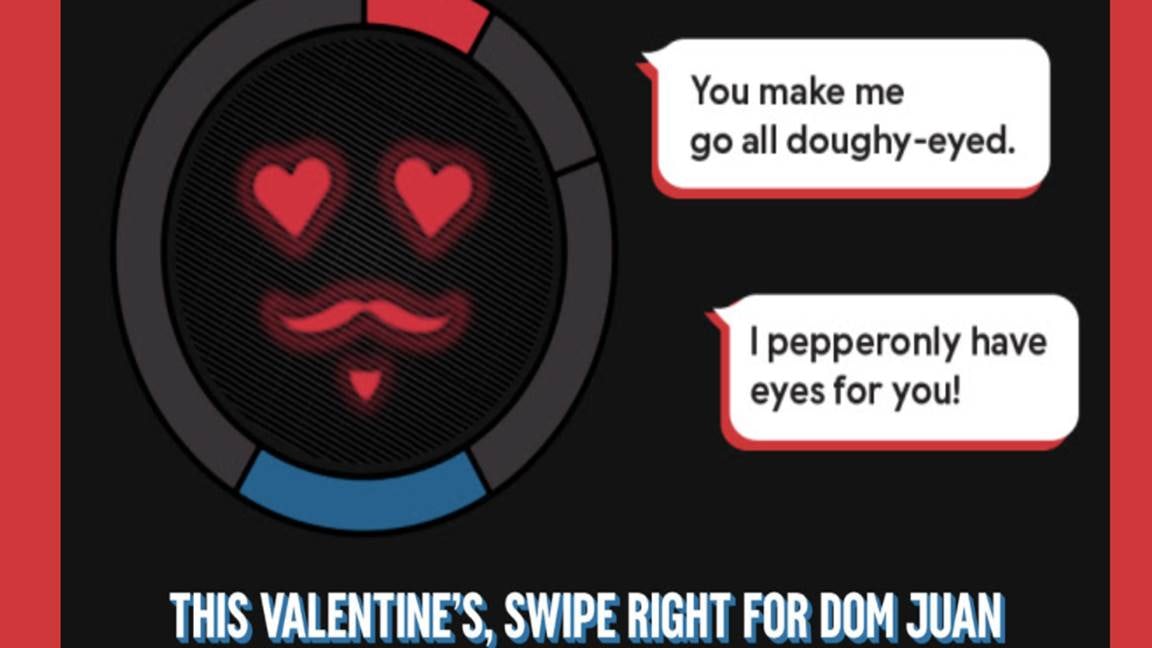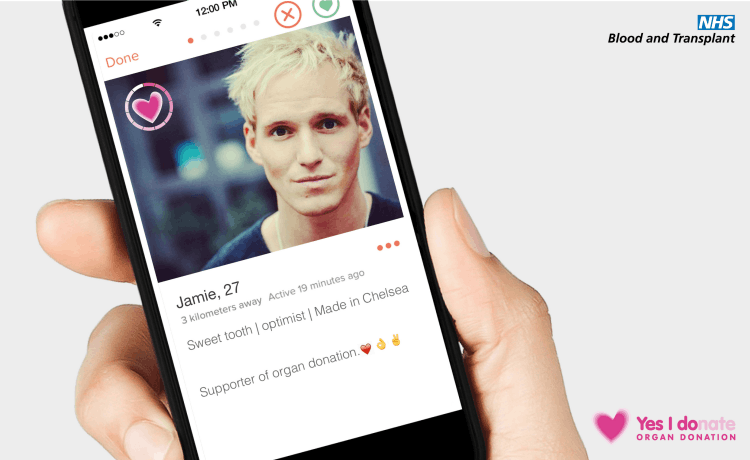To match or not to match: Should brands be paying more attention to dating apps?
Online dating has been around since the dawn of the internet but dating apps are a much newer phenomenon, with their millions of users across the globe offering brands a unique and largely unexplored field to play on.

Tinder is the sort of thing that would have featured in a Black Mirror episode in the late 1990s.
“You do what?” “Right to like, left to ditch.” “But is that not a bit…shallow and dehumanising?” “Pshh, it’s just the way it is now. Look: left left left, right, left, straight into the digital waste bin. It’s as simple as that.”
It is estimated that around 1.6 billion swipes are made on Tinder every day, with roughly 26 million of those resulting in matches and one million progressing to actual dates. Since the popular dating app responsible for many cases of repetitive thumb syndrome launched seven years ago, more than 20 billion matches have been made.
Digital courtship, whether through manic swiping or being able to see who you crossed paths with less than 60 seconds ago, has become the norm for many people across the world. Each month there are 57 million of them on Tinder, 15 million on Badoo, 12 million on Happn, 7 million on PlentyOfFish and 6 million on Grindr.
That’s a lot of deft thumbs and eyeballs.
Online dating isn’t new – Match.com has been around for 23 years and eHarmony for 19 – but with the advent of mobile the ubiquity with which people are using dating apps is. As such, brands are fast beginning to realise the myriad unexplored opportunities there are to match with this unique and growing audience.
Domino’s, for example, has used Tinder as a means to promote its products as the basis for a good date.
Valentine’s Day is one of Domino’s busiest days of the year with around 1,000 pizzas ordered per minute during the dinner date rush. Last year it became the first company to use Tinder’s chatbot services with ‘Dom Juan’, which sent cheesy chat-up lines to matches that could be passed on to other users.
While Domino’s said its primary aim was to “help singletons find love”, it was a clever move that would have put it top of mind and probably resulted in some pizza orders too.

“If you think about single people and the amount of money they spend in the market and the kinds of things they spend money on – restaurants, travel – it’s a great opportunity for marketers to message a really specific audience in a very specific environment,” says Peter Foster, general manager of global advertising and brand solutions at Match Group, which has over 45 brands including Match, OkCupid, Tinder, PlentyOfFish and new kid on the block Hinge.
“If you’re on Tinder and thinking about where you’re going to go Friday night and who you’re going to be with, you’re also thinking where am I going to go, what am I going to do, what am I going to wear, what’s my hair going to look like, what movies are on? It’s a really context-heavy way to reach that single audience versus maybe Facebook which might know you’re single but your mindset on Facebook is very different. You’re leaning back and absorbing content versus thinking about a specific part of how you’re living your life.”
Foster says the most successful brands are those, like Domino’s, that make their creative contextually aware and don’t simply run the same 30-second TV spot.
He highlights that a brand like Diageo, one of Tinder’s bigger clients, is more likely to have success with an ad that says ‘Smirnoff is amazing, here’s £1 off for your date tonight’, or ‘Here’s a great drink to mix at your party this weekend where you might meet someone special’, rather than simply saying ‘Smirnoff is the greatest thing ever’.
“That real understanding of the context and pushing that from a marketers’ creative perspective is really important,” he says.
That real understanding of the context and pushing that from a marketers’ creative perspective is really important.
Peter Foster, Match Group
Man City’s multi-year partnership with Tinder, meanwhile, goes beyond its four walls, offering exclusive access to games, experiences and events, both at the Etihad Stadium and beyond.
City Football Group’s chief commercial officer and managing director of City Football marketing, Tom Glick, says Tinder and Man City share a “really rich space”, especially when it comes to engaging millennials which account for four in five Tinder users.
Then there are more niche platforms that appeal to much smaller brands and businesses, such as ‘conscious dating’ app Deep, which offers relationship coaching to its members to try and eliminate “demoralising” swiping and help create an experience that is positive, supportive and personal.
While the platform has only just launched it says it has already had interest from yoga and meditation brands and is speaking to businesses that are focused on intuitive coaching and astrology.
“The way we see advertising is as a value add for the customers,” the company says. “We are only letting companies advertise if they align with our members’ wants and needs.”
Conversely, and taking a very different stance to many of its peers, dating site eharmony doesn’t have advertising on its platform at all.
“Our goal is helping people find love with like-minded singles, and we want nothing – including adverts – to distract people from the premium user experience on eharmony,” marketing director Romain Bertrand says.
“That’s why we don’t accept advertising, something that is at odds with the rest of the dating industry.”
Swiping for good

But dating apps are being used for more than casual hook-ups and simply marketing to consumers. Where they are proving to be an incredibly powerful tool is with businesses and groups looking to promote social causes.
In February 2019, activist group Lesbians and Gays Support the Migrants handed their Tinder accounts over to a bot designed to teach airline passengers how to spot a deportation happening on their flight and how to stop it.
“Tinder is an app that brings people together, which is why we wanted to use it to highlight how deportations tear communities apart,” explains Sam Bjorn, a spokesperson for LGSMigrants.
“British Airways and other airlines carry out deportations which force people to countries where they have few connections, and could face persecution or death.”
It allowed us to cut through the noise and normalise donation in a disruptive way.
Andrea Ttofa, NHS Blood and Transplant
Amnesty International, The Body Shop and NHS Blood and Transplant (NHSBT) have also used Tinder as a marketing tool to promote campaigns; Amnesty for women’s rights, The Body Shop for a programme aimed at helping endangered species find love, and NHSBT to encourage more young people to sign up to be an organ donor.
Andrea Ttofa, head of organ donation marketing at NHSBT, says partnering with Tinder allowed it to “cut through the noise and normalise donation in a disruptive way”, especially among young people.
During the two-week campaign, NHSBT saw a 92% uplift in organ donation sign-ups, achieved 24 million impressions globally and secured around 70 pieces of media coverage in the UK.
“What was great about it was it didn’t just capture the attention of Tinder users, it actually cut across different channels,” Ttofa says.
“A short-term campaign like Tinder is never going to deliver the ongoing numbers something like the DVLA would or sign-ups through GP practices or any other government channel, but what it did do is generate noise outside of that registration channel and bring organ donation to the attention of a group that is quite hard to engage.”
To match or not to match

Compared with Facebook’s News Feed, which has become increasingly cluttered with ads of all sorts, Tinder, where all advertising opportunities are in-app, serves up one ad every 30 profiles. This is no doubt a huge selling point for a wide variety of brands looking to cut through the noise and boost effectiveness in a way that doesn’t irritate users.
Tinder has also begun its foray into programmatic advertising to make the platform more accessible for smaller brands who don’t have $25,000 (£19,000) to spend, the minimum investment Tinder usually asks for.
This is where businesses like Match will need to find the balance between continuing to be an attractive and lucrative platform for brands but without ruining the user experience by opening up its doors to too many ads.
And of course, like everything with a digital pulse, dating apps are not without their challenges and there are obvious issues around brand safety.
Fake profiles, ‘catfishing’, unsavoury photos, profiles endorsing homophobia and racism: dating apps are a minefield of unregulated territory, with no surefire way to stop an ad from appearing next to a photo of someone’s genitals or above the profile of a far-right extremist or unapologetic misogynist looking for love.
At a time when the majority of brands are on high alert and doing everything they can to avoid doing anything that could harm their brand, the risk – as it stands – perhaps outweighs the value for some.
But dating apps have come a long way in recent years and as they mature they will continue to evolve for the benefit of both the users and advertisers they serve.
“Not only are they much more socially accepted now than they once were but through the use of AI, they’ve also got better at filtering salacious content, as well as providing more sophisticated ad formats,” says Jenny Barthe, strategy director at We Are Social.
“To date, we have only seen a small number of brands harnessing dating apps as a communications channel, so it seems like there is still quite a lot of unexplored creative opportunity here. And especially considering these platforms are now a part of the normal fabric of young people’s lives – why would you not swipe right?”
While for some dating apps like Tinder are more of a dystopian nightmare than they are a handy tool to help people find love, or sex, or whatever it is they want, all the signs point to them being here to stay. Especially as mobile phones continue to impede on our ability to have real-life conversations with real-life humans.
And on the off-chance an ad for pizza pops up next to a photo of someone’s nether-regions, what’s to say that won’t boost brand salience or result in a sale? There’s only one way to find out.







Comments